Does 19th St. detention pond need a fence? City engineers explore open-space options
|
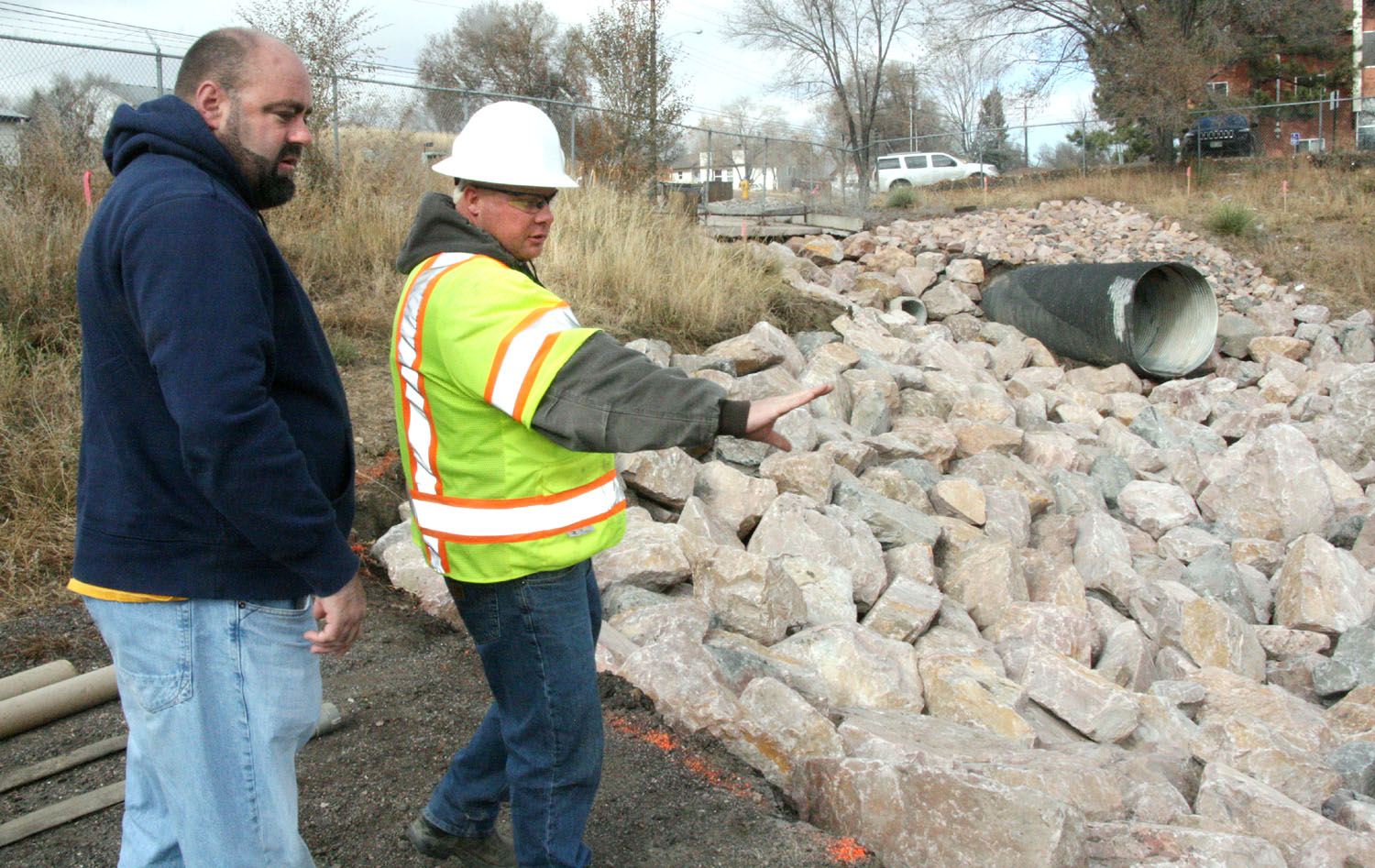 Steve Burke (left), the city's project
manager, and Chuck Hickox, the foreman with the contractor, Pioneer
Sand, discuss technical aspects of the work at the city's 19th Street
stormwater-detention pond. They are standing near the largest pond
inlet (72 inches in diameter), carrying drainage from 19th Street
(beyond the fence in background). The large rocks around the inlet are
part of a concrete/rock structure being built at that point to reduce the
force of water flowing in during a storm.
Steve Burke (left), the city's project
manager, and Chuck Hickox, the foreman with the contractor, Pioneer
Sand, discuss technical aspects of the work at the city's 19th Street
stormwater-detention pond. They are standing near the largest pond
inlet (72 inches in diameter), carrying drainage from 19th Street
(beyond the fence in background). The large rocks around the inlet are
part of a concrete/rock structure being built at that point to reduce the
force of water flowing in during a storm.
Westside Pioneer photo
|
Idea arises as $400,000
pond-fix project nears completion
But a side story is taking shape that might have more of a day-to-day impact on the surrounding neighborhood.
That would be to remove the barbwire fence that has surrounded the property at 19th and Dale streets for about half a century and open the space to the public.
“I don't know why it's got a prison fence around it,” said Tim Mitros, the city's stormwater manager, in a recent interview. “We could turn it into something of value to the neighborhood.”
Several storm pipes carry drainage to the pond from the east side of 19th and uphill properties to the north and east. The pond detains the water (hence the name), then releases it gradually into the downstream system. In this respect, the 19th Street pond is similar to others in the city.
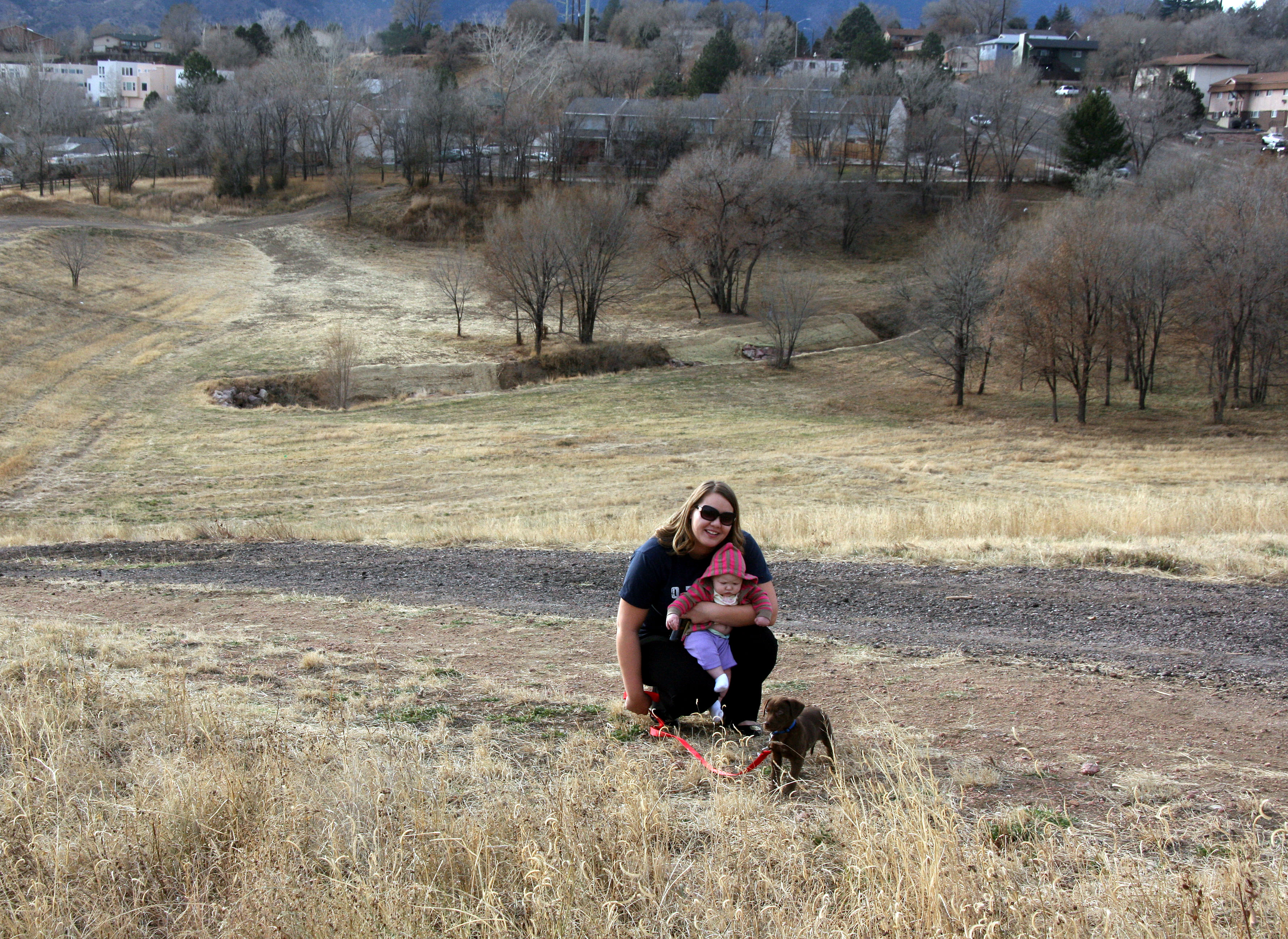 Chrystal Munson, who lives in the
neighborhood, poses with her 5-month-old daughter Annalya and 7-week-old
puppy Trusty during their recent walk through the King Street detention pond,
which has no fence around it. The new channel work can be seen across the upper-
middle part of the photo. Collecting stormwater from the residentially developed
hillside above it, the King Street pond is located about a mile away from the
fenced-in 19th Street pond.
Chrystal Munson, who lives in the
neighborhood, poses with her 5-month-old daughter Annalya and 7-week-old
puppy Trusty during their recent walk through the King Street detention pond,
which has no fence around it. The new channel work can be seen across the upper-
middle part of the photo. Collecting stormwater from the residentially developed
hillside above it, the King Street pond is located about a mile away from the
fenced-in 19th Street pond.
Westside Pioneer photo
|
“It's like what we're trying to do with a lot of creeks, so people can enjoy them,” he said. “We put trails by them and make them an attraction.”
An example less than a mile away is the detention pond off King Street, almost 10 acres in size, where on a recent sunny afternoon people could be seen walking with children and dogs. Other than the channel in the central low point - upgraded with stormwater-slowing boulders in a city project earlier this year - most of the space consists of natural grass and trails.
Plans to unfence the 19th Street pond area (about 4 acres in all) are conceptual at this point (as are the costs) but Mitros thinks the timing is good. The current project is cleaning up the property, including taking care of mud issues, creating channels for normal water flows from the inlet pipes, giving the site a more natural look and grading to even out the gentle downward slope to the new outfall structure at the pond's southwest corner. The open-space appearance will be enhanced in the months ahead as natural grasses (to be seeded
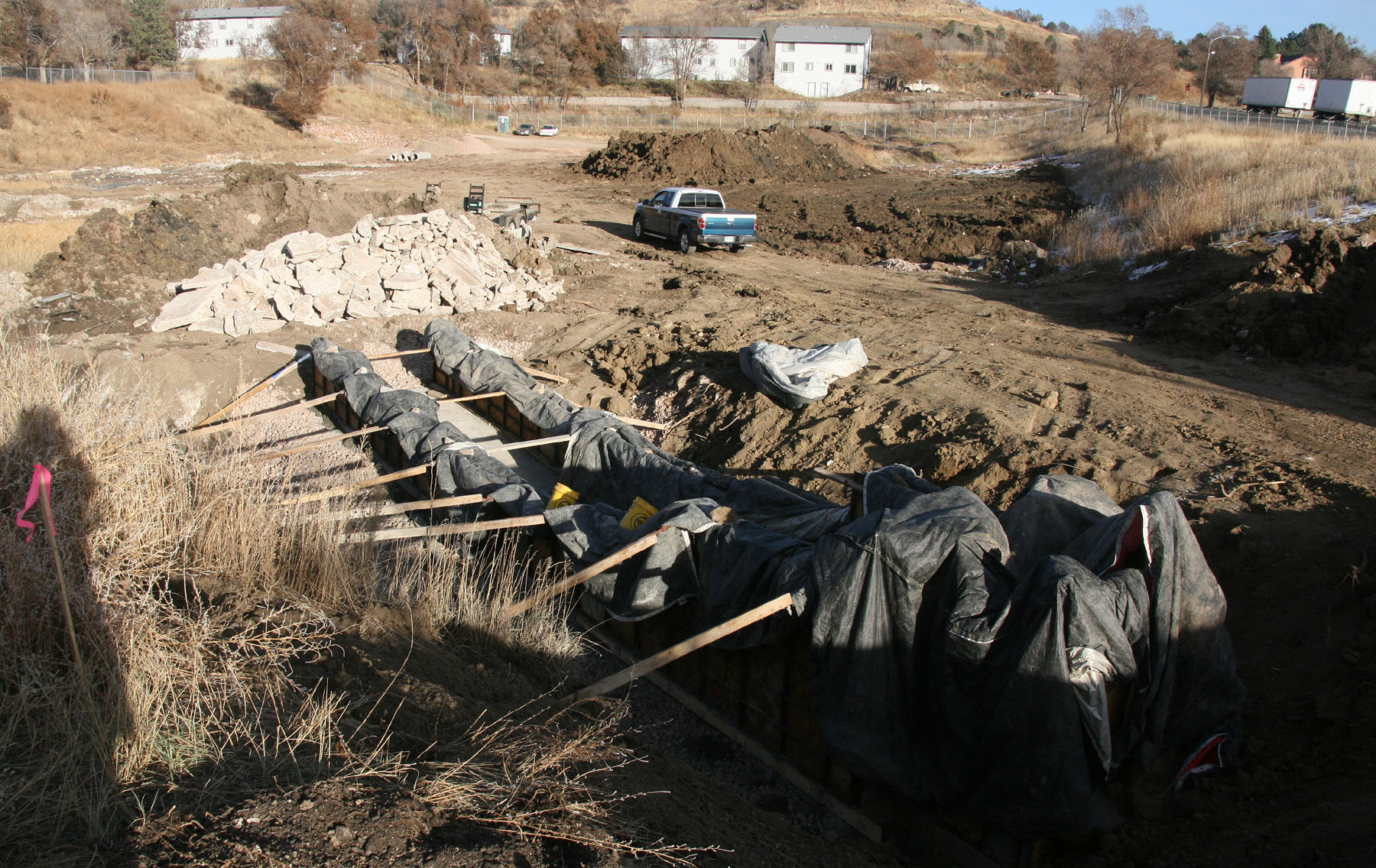 In a photo shot looking east around the third
week of November, the extent of the 2-acre pond under construction can be seen
in the late afternoon. The new concrete outlet structure, which had just been
poured the day before, was covered to protect it against sub-freezing night
temperatures.
In a photo shot looking east around the third
week of November, the extent of the 2-acre pond under construction can be seen
in the late afternoon. The new concrete outlet structure, which had just been
poured the day before, was covered to protect it against sub-freezing night
temperatures.
Westside Pioneer photo
|
But before opening the pond to the public, Mitros would like to have a sense of community support as well as a source of income to pay for what could be increased maintenance needs. Among the calls he plans to make are to City Parks, to see what possibilities exist in that department (although he doubts it has any “extra” funds) and to contact businesses in the area. For example, he pointed out that the city has established a public/private partnership with a major home builder in upgrading a park in the Mountain Shadows neighborhood that was afflicted by the Waldo Canyon Fire.
As far as community support, Mitros already has the backing of Sallie Clark, a county commissioner and Westside resident. “I drive 19th Street a lot, and that's always been a horrible eyesore,” she said, when contacted by the Westside Pioneer. “New detention facilities don't have those fences. Taking the fence down would certainly improve the looks of it.”
She said that she herself has been talking up the idea for several years - including conversations with key officials in the city's Public Works Department. With the current
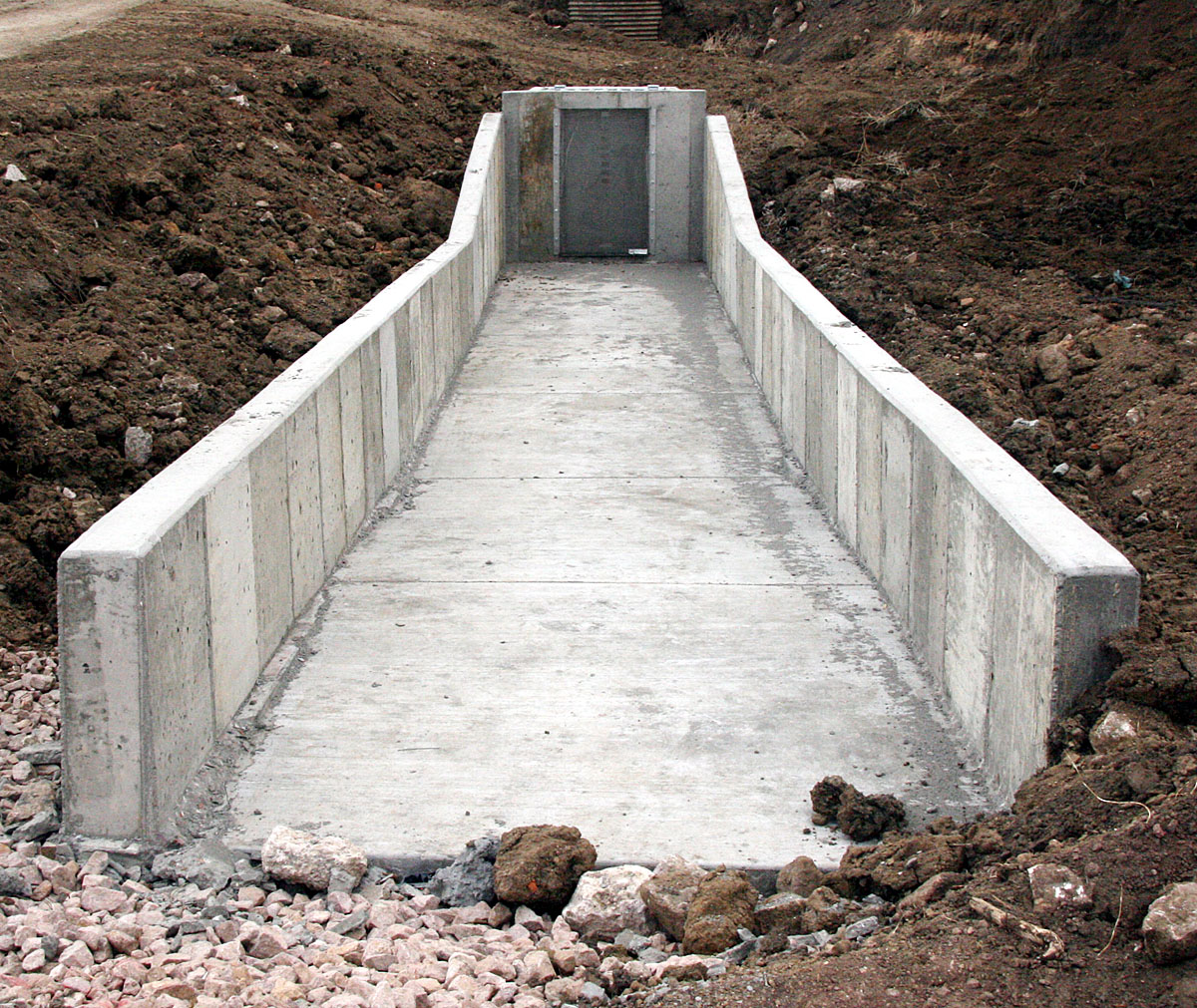 As construction continues on the 19th Street
detention pond, its new outlet structure is seen about a week after the photo
above. The area in front, which is the lowest part of the pond, is called a "micro
pool." The design continues the engineering intent to use the pond to hold back the
water in a rainstorm. For example, the water will need to find its way through
small openings in what looks like a door in the structure at the back end of the
pool.
As construction continues on the 19th Street
detention pond, its new outlet structure is seen about a week after the photo
above. The area in front, which is the lowest part of the pond, is called a "micro
pool." The design continues the engineering intent to use the pond to hold back the
water in a rainstorm. For example, the water will need to find its way through
small openings in what looks like a door in the structure at the back end of the
pool.
Westside Pioneer photo
|
The present city hope is that a final decision on taking down the fence can be made before the current project is finished. The tentative completion date is Dec. 15, according to Steve Burke, the city's project manager, and Chuck Hickox, the foreman with the contractor, Pioneer Sand.
Improving the 19th Street pond has been high on the city's stormwater list for a number of years - not because it's failing, but because of federal water quality requirements. Its high priority is evident, in that the city decided a year ago to pay the full cost from its own funds - unlike some projects (such as Camp Creek in Pleasant Valley) that were held back to see if the stormwater ballot issue would pass in the November election or the King Street pond (whose approximately $100,000 cost was 75 percent funded by the Federal Emergency Management Agency). Regarding the quality aspects, Mitros said that the city “used to just have a pipe that exited the pond. There's way more to it nowadays. You have to let it out really, really slowly.” The effect, he explained, is that many pollutants that used to leave with the water (such as oils, antifreeze and trash) will now be left behind and settle out in the pond. City vehicles will drive in periodically to dredge up the stuff and haul it away.
One other major aspect of the project is to increase the pond's capacity from 20 acre feet to 24½. There have been times in the past (including last summer) when the pond has come close to overflowing in major rainstorms. Burke said the increase is being accomplished by using excess dirt from the project to build the berm two feet higher along the 500-foot-long south side of the pond.
When that work is done, the pond “will handle a large storm without overflowing,” Burke said.
From a big-picture standpoint, improving the 19th Street and King Street ponds is only part of the solution to the Westside's stormwater problems. According to city engineers, both ponds drain into a system that is not only undersized as its pipes carry excess water to Fountain Creek, but is also antiquated (more than 80 years old in some cases), city studies have shown.
One offshoot of the undersizing problem is the flooding that often occurs during big rains on 19th Street and Glenn Avenue, a few hundred feet north of Uintah. As a result, that problem will continue even after the 19th Street detention pond work is complete, Burke pointed out.
Replacing or repairing many of those storm pipes were priorities in the recent stormwater ballot question (with a price tag of $8.3 million). However, that work is currently unscheduled, in the wake of the question's failure at the polls.
The following paragraph has been changed from its original version, based on a follow-up phone call from Mitros Dec. 1. Before Dec. 1, he had not been sure when the pond was built. But in the Dec. 1 interview, he said he had found records indicating that the year was 1968. This was a few years before the main development of the 19th/Uintah area. County Assessor records show the apartments north of the pond being built in 1973 and the Uintah Gardens shopping center south of Dale Street in 1974. However, Mitros could find no information about when the fence was installed or if it had been there from the start.
Westside Pioneer article
(Posted 11/29/14, updated 12/2/14;
Projects:
Flood Control)
Would you like to respond to this article? The Westside Pioneer welcomes letters at editor@westsidepioneer.com. (Click here for letter-writing criteria.)
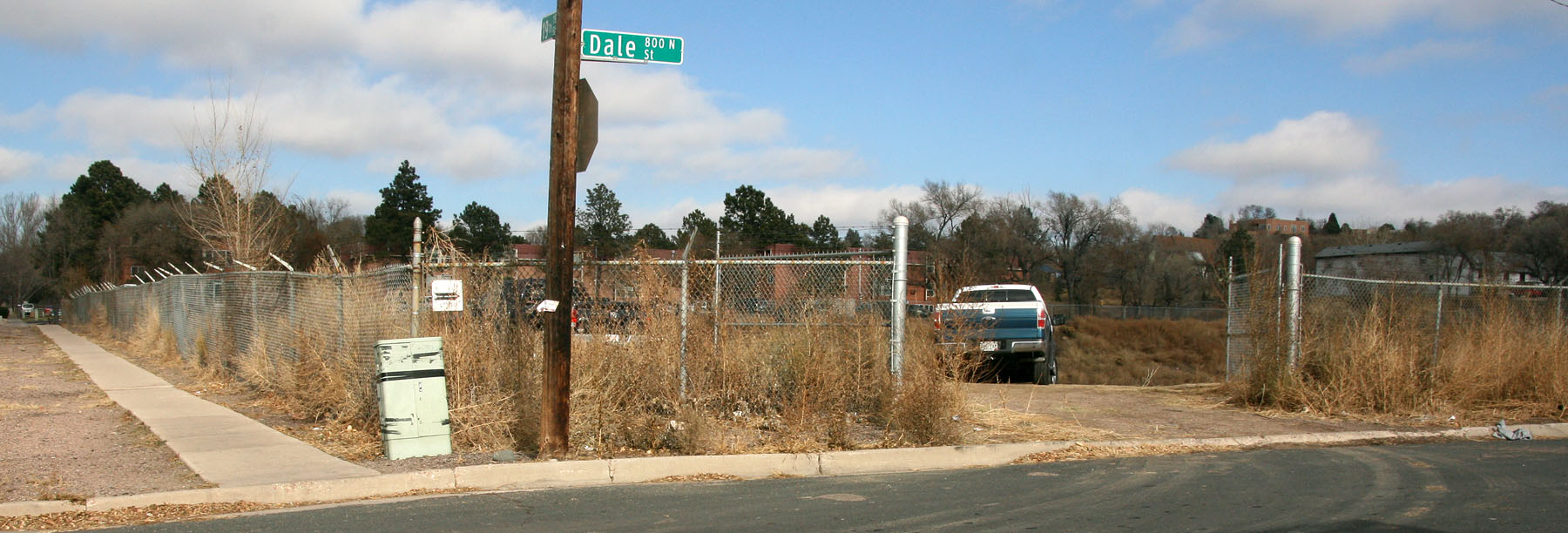 A view looking northeast from 19th Street
shows the southwest corner of the city's 19th Street stormwater-detention pond at
19th and Dale streets, with a barbwire fence around it. For many years, the fence
has kept the public out of the property, but now (in conjunction with an upgrade
project nearing conclusion) the city is thinking of removing it.
A view looking northeast from 19th Street
shows the southwest corner of the city's 19th Street stormwater-detention pond at
19th and Dale streets, with a barbwire fence around it. For many years, the fence
has kept the public out of the property, but now (in conjunction with an upgrade
project nearing conclusion) the city is thinking of removing it.